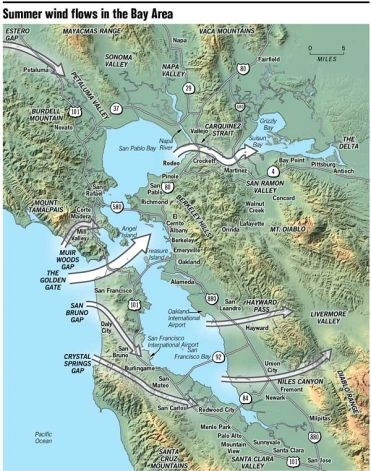
The New Sunset Western Garden Book divides Napa County into four climate zones. Each zone is influenced by elevation, slope and exposure. But what does that really mean to the Napa Valley gardener?
Take a walk through your own garden and notice the variation in light, temperature and moisture. A journey of just a few feet in your own backyard may take you from one set of conditions to another. In all likelihood, your garden is a collection of discrete areas with different environmental characteristics and planting possibilities.
Examine these different areas with an eye to finding just the right spot for the right plant. Understanding your garden’s microclimates could involve documenting daily sun angles, minimum and maximum temperatures, wind direction and rainfall. Or it could simply involve a quick plot of shady and sunny areas. Using just the information about sun exposure and soil moisture, you can probably identify four microclimates in your yard:
- Dry soil in sun
- Dry soil in shade
- Moist soil in sun
- Moist soil in shade
Use these four groups as a framework. At the nursery, you’ll find most plants labeled with information about suitable climate zones, sun versus shade preference, drought tolerance, full-grown size, and disease and pest problems. Use this information to match plants to the right spot in your garden.
The following plant suggestions come from the University of California Cooperative Extension’s “Healthy Garden Tips: Creating Microclimates in the Garden,”adapted from an articleby Peggy Sullivan.
For dry soil in sun: Consider silver bush, flannel bush, red monkey flower, lavender, rosemary, ornamental grasses, agapanthus, lemon thyme and mint.
For dry soil in shade: Consider ceanothus, monkey flower, California wild fuchsia, Siberian and Japanese iris, and New England aster.
For moist soil in sun: Consider spider wort, cardinal flower, ribbon grass, horsetail and hosta.
For moist soil in shade: Consider ferns, broad-leafed bergenia, dogwood, azalea, Japanese maple, elephant’s ear, maidenhair fern, tree fern, common calla, caladium and hosta.
Keep in mind the seasonal variation in sunlight. One of the most changeable factors in my own yard is the play of sun versus shade. I have areas that receive full sun year round and others that are shaded most of the time. A south-facing wall regularly gets eight hours of sun and is great for vegetable growing. Since the area receives drip irrigation, it’s an example of moist soil in sun.
Just steps away, an area under a grapefruit tree in the lee of a garden shed is in perpetual shade—an example of moist soil in shade. Other areas only receive sun when the leaves have dropped from the neighbor’s trees. These zones provide havens in the summer for plants that prefer shade while providing sunny exposure for cool-weather growers.
Just as bodies of water, mountains, hills and valleys affect wind patterns and temperatures, so do the structures and the terrain on your property.
- South- and west-facing stucco walls provide radiant heat that can help ripen summer vegetables. The growing season of a frost-tender plant can be extended by planting it here.
- Eaves can provide a measure of frost protection and relief from direct rain for delicate plants.
- Fences can provide zones of shade along the south side of a yard and zones of reflected heat on the north side.
- North walls receive little direct sun and provide shelter for plants that prefer a shady environment.
- Trees and hedges can act as wind breaks.
- Planting on sloping ground takes advantage of the warming of cold air as it flows downhill.
Finding the right plant for the right place goes beyond choosing appropriate size and desirable color. Knowing the different environments in your garden can aid you in making more informed plant choices.
With an eye to a year-round garden, choose plants and vegetables that bloom and produce in different seasons and that thrive in the conditions that change foot by foot and month by month in your garden.
Vegetable Workshop: Napa County Master Gardeners will lead a workshop on “Cool Season Veggies” on Sunday, August 18, from 2 p.m. to 4 p.m. at the Yountville Community Center, 6516 Washington Street, Yountville. Grow your own vegetables even when days are short and nights are cold. The key is starting while weather and soil are still warm. Learn which vegetables will thrive in cooler temperatures, how to protect them from heat when they are getting started, and how to time plantings for months of harvest. $15 per person ($10 for Yountville residents). Register through Town of Yountville, Parks and Recreation: Mail in or Walk in registration (cash or check only). For additional information, call (707) 944-8712 or visit their web site.
Master Gardeners are volunteers who help the University of California reach the gardening public with home gardening information. Napa County Master Gardeners ( http://ucanr.org/ucmgnapa/) are available to answer gardening questions in person or by phone, Monday, Wednesday and Friday, 9 a.m. to Noon, at the U. C. Cooperative Extension office, 1710 Soscol Avenue, Suite 4, Napa, 707-253-4143, or from outside City of Napa toll-free at 877-279-3065. Or e-mail your garden questions by following the guidelines on our web site. Click on Napa, then on Have Garden Questions?